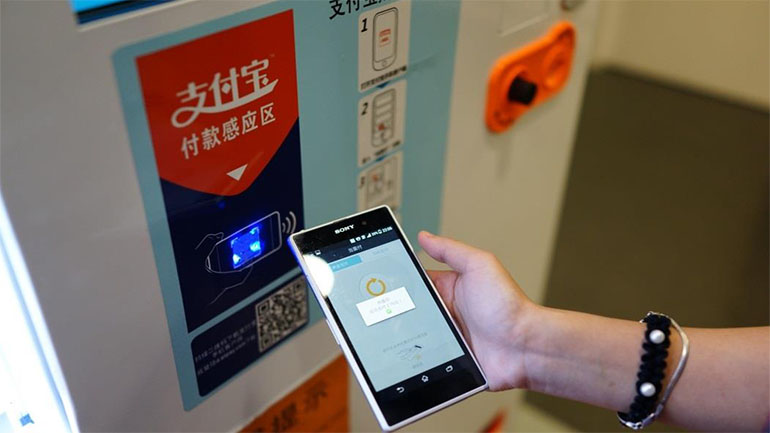
If you chose to do so, you could live in Shanghai without carrying anything so plebeian as cash (or even credit cards). Chinese consumers can (and do) swipe smartphones for almost everything.
在上海,只要你愿意,身上可以不用带任何像现金(或信用卡)这样的平民化的东西。中国消费者可以用智能手机购买几乎任何东西并付款,很多人也确实在这么做。
Breakfast, lunch and dinner? With a wave of the iPhone wand, it arrives on a motorbike, delivered often for free and usually at a discounted price, from food delivery apps such as Ele.me (meaning "are you hungry?"). Wave it again, and a taxi appears, ready to offer a discounted ride. Wave it once more, and there's a doctor ready to diagnose any ailment by phone for only Rmb9.9 ($1.5) per call.
不论是早餐、午餐还是晚餐,挥一挥iPhone魔杖,就有人骑电动车送上门——在“饿了么”等外卖APP点餐通常免配送费,还经常打折。再挥一下魔杖,出租车来了,以折扣价载你出行。再挥一下,就有医生通过电话给你看病,每次通话仅需9.9元。
It's called O2O, or "online to offline", and is forecast to grow at a compound annual rate of 63 per cent between now and 2017, to Rmb42bn, according to Credit Suisse. The marriage of online and offline will soon come even to that most traditional of venues, the neighborhood wet market, where Shanghainese will be able to swipe a phone to buy anything from a haircut to a tooth extraction to a fish head for supper.
这被称为O2O,或者“线上到线下”,瑞信预计,O2O从现在起到2017年将以63%的复合年率增长,将达到420亿元人民币规模。线上和线下的结合很快还将走进社区菜市场这种最传统的购物场所——届时上海人用手机扫一扫,就能够为从理发到拔牙、再到购买晚餐鱼头等各种服务和商品付款。
A wet market in Wenzhou, in eastern Zhejiang province, has already started letting consumers wave their mobile phones at all of its goodies, and pay with Alipay, the mobile payments service affiliated to ecommerce group Alibaba. Shanghai plans to follow suit, at which point I will be able to load up on a bucket of eels or a leg of pork (with hoof attached) without pulling out my purse.
浙江省东部温州市的一家菜市场已经开始允许消费者用手机支付宝扫码购买所有商品。上海也计划推出这类菜市场,届时民众可以不用掏钱包,就能买上一桶鳝鱼或一条猪腿。
Personally, I still prefer grimy, germ-laden piles of Rmb100 notes with the face of Mao Zedong on them for most of my shopping. But hardly anyone else does (or at least hardly anyone middle class and under 40). At the government-subsidised Loving Help breakfast cart near Shanghai's People's Square, men in suits queue up during morning rush hour to swipe their smartphones for a steamed bun or a shouzhuabing, a delectably greasy Chinese-style crepe that literally translates as "hand-grab pancake". I'm all for that: I prefer it if the hand grabber of that pancake to serve it to me has not just been handling a wad of the people's currency (with all the people's bacteria on it).
就一些人而言,购买大部分商品时仍宁愿拿着一叠沾满细菌、上面印着毛泽东头像的百元钞票付款。但也有人不愿意,至少中产阶级和40岁以下年轻人不愿意。上海人民广场附近受政府补贴的便民早餐车前,西装革履的男士们在早高峰期间排队用智能手机为他们的馒头或者手抓饼扫码付账。我非常赞成这种方式:如果递给你手抓饼的人没有接触过那些上面沾有所有人细菌的人民币,那么你会更喜欢这种食物。
Outside a nearby office building, an Ele.me delivery man squats next to a blue insulated cooler bag, from which he dispenses 30-odd breakfasts — ordered in advance by people presumably working so hard to keep the slowing economy afloat that they do not have time to walk two minutes to the nearest fast-food emporium.
在附近一幢写字楼外面,一位“饿了么”的派送员蹲在一个蓝色隔热保温袋旁,他要配送顾客们预定的30多份早餐,这些人想必为了维持不断放缓的经济而非常努力地工作,以致于没有时间走上两分钟去附近快餐店吃早餐。
Lunch is, if anything, even easier: in the bowels of the same building is a vending machine called the Fun Box dispensing app-ordered meals paid for by smartphone.
如果说午餐有什么不同的话,那就是更方便一些:在同一幢大楼里有一个被称为“Fun Box”的自动售卖机,消费者可以在售卖机自取通过APP预订并付费的午餐。
Dinner? Even the local greasy chopstick accepts payment by swipe-phone. Zhou Lijuan, 29, an accountant at a Shanghai state-owned enterprise, says she hardly ever carries cash any more. "Sometimes Rmb1,000 in cash can stay in my purse for months."
晚餐呢?即便是当地油腻的小店也接受手机扫码支付。一位现年29岁的上海国企会计师周丽娟(音译)表示,她现在几乎都不带现金了。“有时候我钱包里1000元人民币能放好几个月。”



 闽公网安备 35020302035673号
闽公网安备 35020302035673号
0 responses on "Chinese swipe smartphones for almost everything"